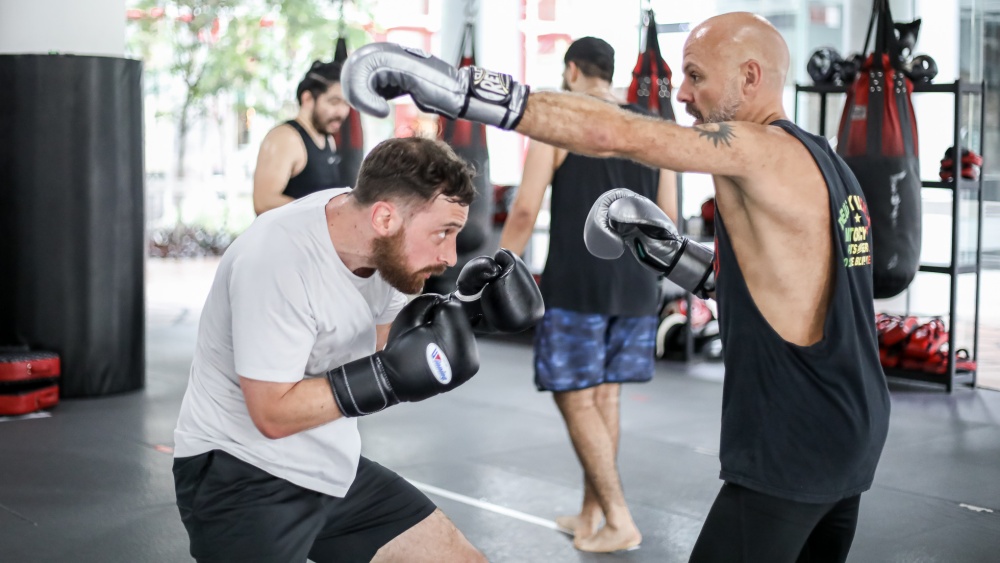It’s a commonly asked question, especially for those who have just started training in boxing. Does shadow boxing with weights help improve hand speed and increase your knockout potential?
The pros do it, sure. You’ve seen guys like Floyd Mayweather and Canelo Alvarez pick up a 3-lb. weight and start working with it. But the simple answer is no, it doesn’t turn you into a knockout artist, at least not directly.
There is so much more that goes into building knockout potential that goes beyond just improving your speed and power. There’s the technique, of course. That’s pretty obvious. But there’s also timing, execution, strategy, and so on. It’s a complex facet of the fight game.
There is, however, a caveat. Adding resistance to your punch training does have its benefits. It helps fortify your shoulders and trains the right muscles, which give you the added quickness and pop to your shots.
If you’re looking to add resistance training elements to your boxing routine, then we’ve come up with a few things you may want to try out the next time you’re in the gym. We go into detail on these training techniques that will help improve your knockout power.
Today, Evolve Daily shares five ways to add resistance to your punch training.
1. Shadowboxing with weights
Let’s just get one thing clear. Shadowboxing is not a strength and conditioning exercise. It’s meant to hone your technique and zero in on your execution, rather than develop your muscles and build your strength and power.
In that sense, shadowboxing with weights is meant to train your arms and hands to move with added resistance, mimicking the heaviness you feel in a real fight. In a real fight, your arms get tired, to the point that you can barely keep your guard up. Shadowboxing with weights simulates that situation somewhat and trains your body to deal with that sort of fatigue.
When you’re shadowboxing with weights, focus on making slow and controlled movements as you’re punching. Don’t put everything behind your punches, don’t throw them with maximum speed and power. Instead, focus on your timing and your execution, with the added resistance.
2. Heavy bag with heavier gloves
Another technique the pros practice is hitting the heavy bag with bigger, heavier gloves.
The reason why pros train with heavy gloves (16oz. – 22oz.) is to add resistance to the training. The idea of adding weight to your boxing workouts is to make things harder and add another layer of difficulty to a specific drill.
Heavy bag training is very flexible, and there are a lot of ways you can train with the heavy bag. For the purpose of adding resistance to your punch training, focus on hitting the bag with volume. Try to throw at least 100 punches per three-minute round. Wear a heavier glove each time you train on the heavy bag, and increase it gradually.
Maintaining punch output and volume is key to getting the most out of a heavy bag workout.
3. Barbell punching exercise
You’ve probably seen this exercise multiple times on television. The pros take a barbell rod with one hand and punch out with it. The added resistance and weight of the barbell rod make this exercise extra difficult, and you’ll be gasping for oxygen after just a couple of rounds. Take your time and slowly build strength as your progress.
Alternate with both hands and perform multiple sets, or until your arms feel like jelly. This is a terrific workout that not only adds resistance to the standard punch motion but also accustoms you to the proper execution of punches.
Furthermore, you can add even more resistance by slapping a plate or two onto the end of the rod. As your body adjusts to the difficulty of the workout, continue to challenge yourself.
It’s a basic workout that has fantastic results if you take the time to put in the effort.
4. Use elastic resistance bands
Working with resistance bands isn’t something new in boxing. In fact, professional boxers for years have used elastic resistance bands as part of their training.
The idea is to stand with your back to the elastic band, holding an end of the band with each hand. In a smooth, rhythmic motion, punch on one end of the band by stretching it, and come back with the other hand.
Again, perform this exercise in a slow and controlled motion, paying extra careful attention to execution and technique.
Boxing has incorporated the use of resistance bands in recent years, with more and more elite boxers turning to resistance band workouts to complement their usual training routines. The elastic band has many applications in training and provides many benefits.
Many boxing coaches have had their boxers work with resistance bands because not only does it help in developing lean muscle, but also helps improve range of motion, which is very important in boxing.
5. Shadowbox underwater
Last but certainly not least, this one requires you to step outside the gym and jump into the swimming pool.
We’ve all tried it before, shadowboxing underwater. The speed is sacrificed when you deal with water pressure. That’s why it’s so hard to move underwater. This makes underwater shadowboxing a very challenging workout.
The next time you’re at the pool, do three rounds of shadowboxing while holding your breath underwater. It adds resistance to your punch combinations and trains your muscles to deal with that underwater pressure. This, in turn, builds your punch stamina and allows you to perform combinations without getting tired.
Not only that, but working out underwater also helps you develop your lungs and teaches you how to manage your oxygen levels, which no doubt comes in handy when you’re in a fight or competing.
You may also like:
3 Simple Knockout Combinations You Should Have In Your Boxing Arsenal

















